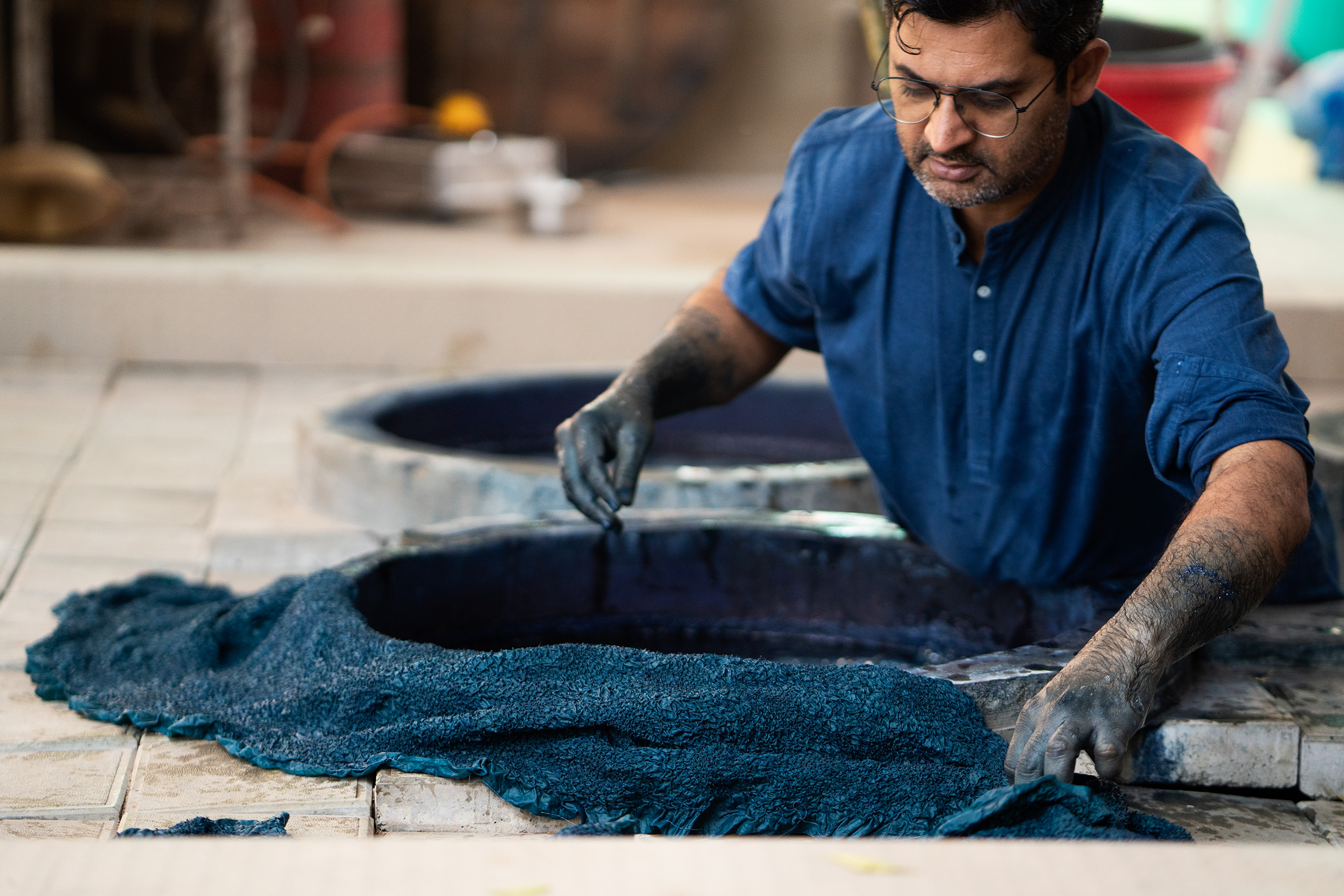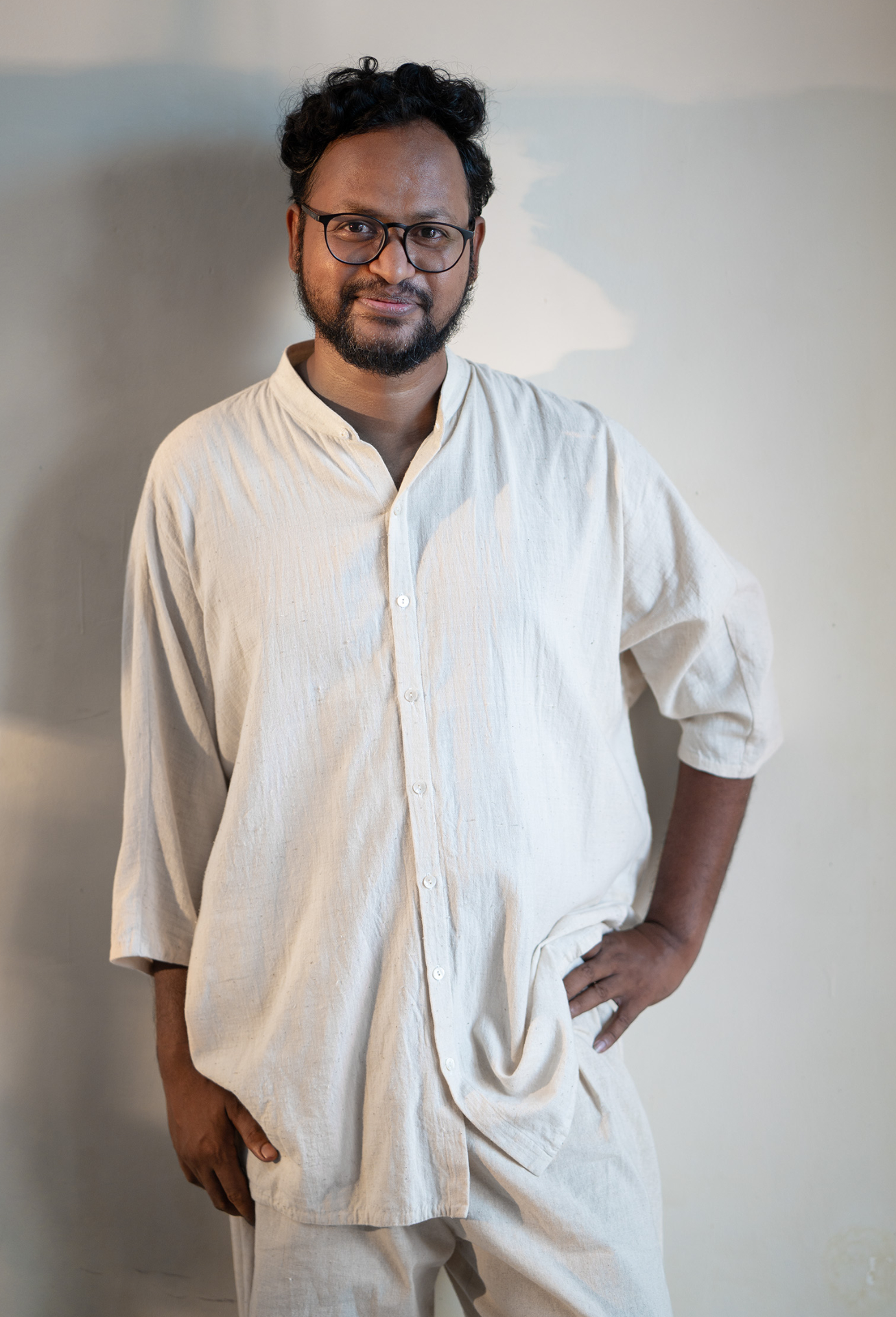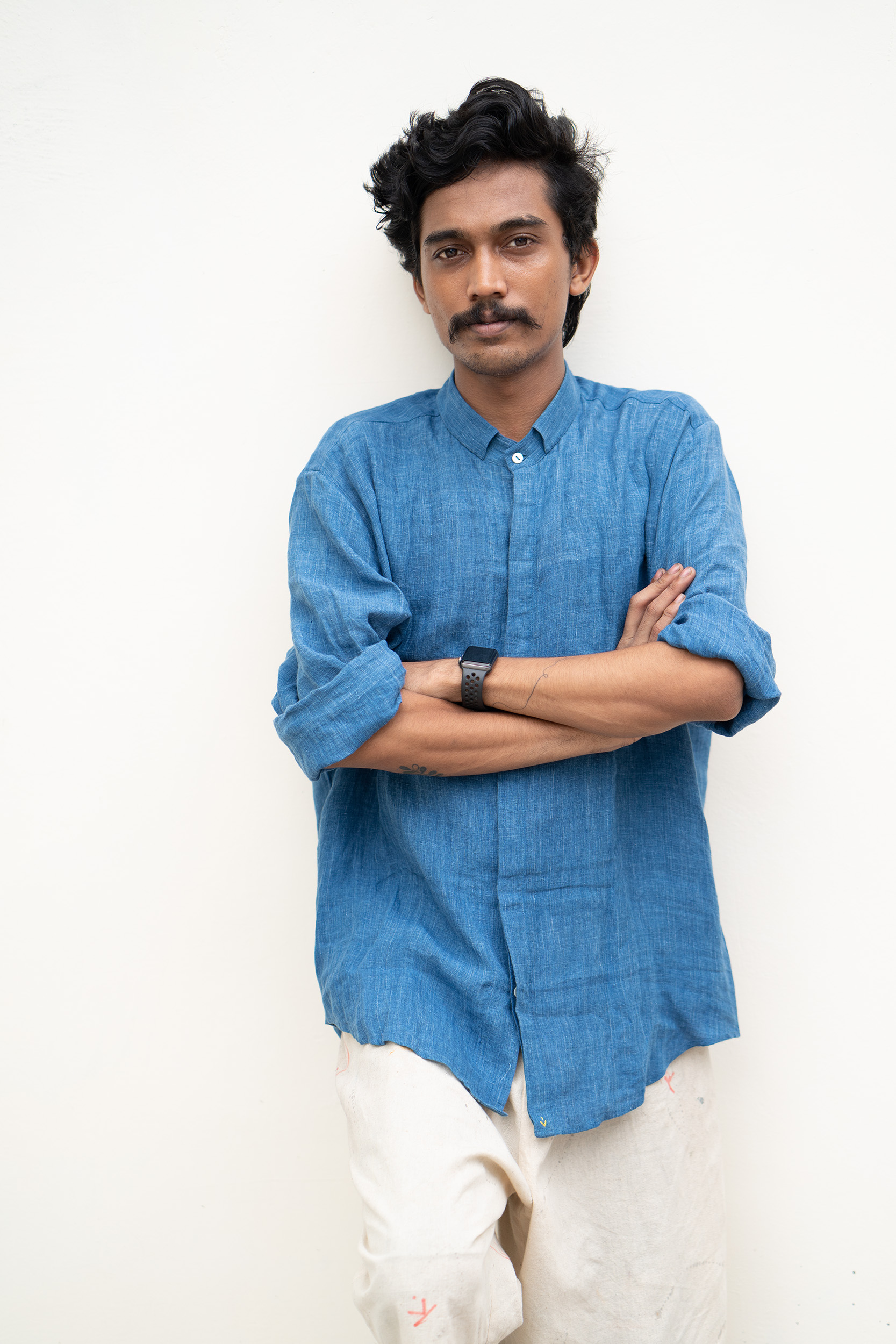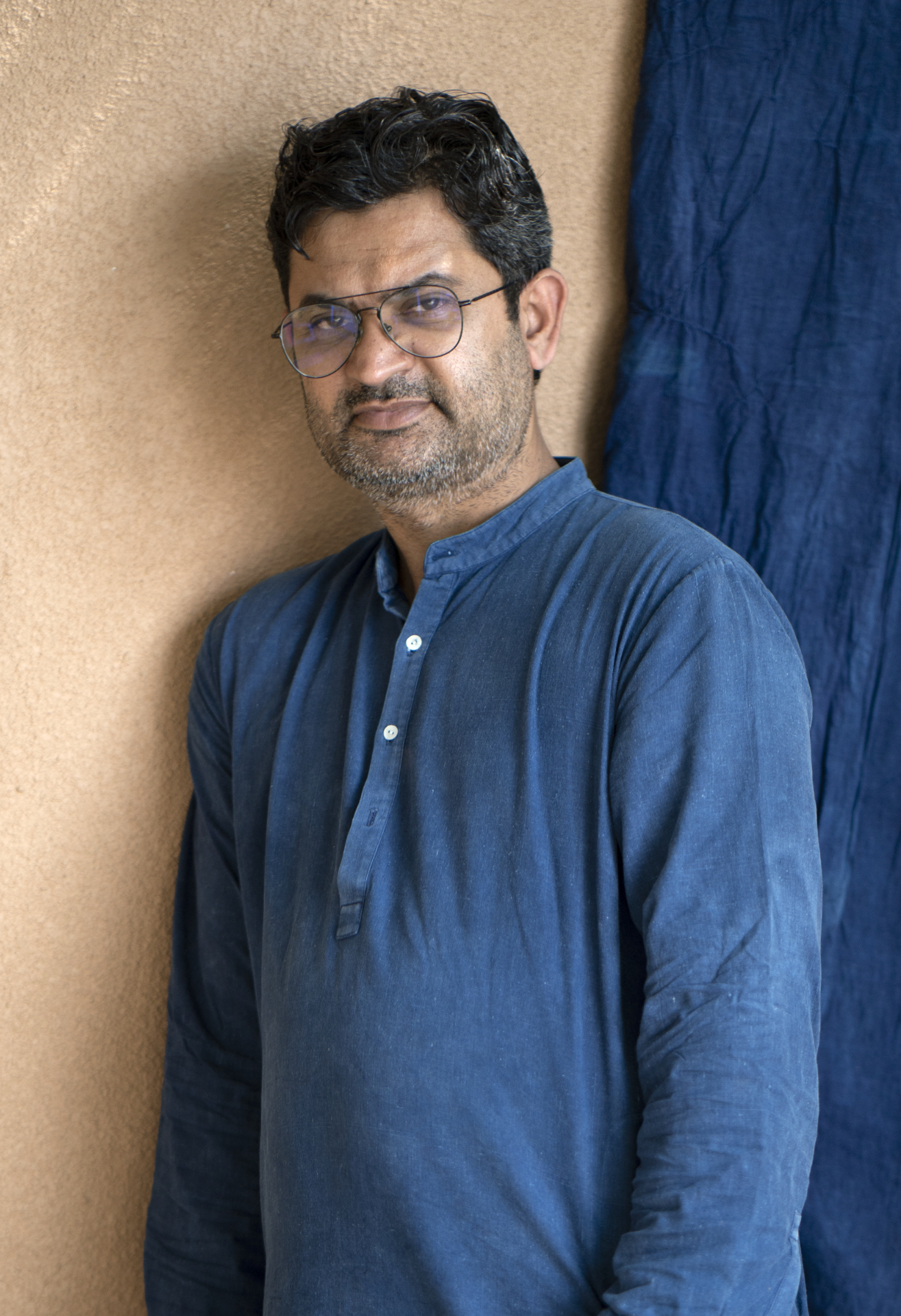Mr Khatri, how did you start in your profession? Was it a family tradition and was it expected of you to continue the craft? If it wasn’t a family trade, did you learn later – and who taught you?
Abduljabbar “Jabbar” Khatri: We were born and grew up in area called Khatri Chowk in Bhuj (Kutch district). The place got its name because of the concentration of Khatris who are traditional tie-dyers in this neighbourhood. Bhuj is Kutch district’s principal town and historically its main trade centre.
Our family had lost direct touch with the craft, since our great-grandfather got into making fireworks for the royalty, our grandfather got into bicycle repair, while my father began working at a bank. Because of these changes in profession, our family had lost its direct link with the craft. The family had been going through hard times, and my grandfather wanted his sons to get educated to secure a better future. Those were the days of fast growth, and new jobs were opening up with fewer takers around! My father took a job in a bank because in those days this provided much-needed security and consistent income for the family.
We grew up in such an interesting time. On one hand, I was exposed to the world of education, since my father received a formal education (bachelor of arts) and became a man of learning, while on the other hand my uncles and cousins started flourishing as craftsmen. They experimented with a variety of fabrics, colours and designs that were not earlier available to our elders. As children we were fascinated with the tying and dyeing being done by elders and other families in our neighbourhood. We were also interested in our studies but became more absorbed in our traditional craft practice. We used to stay at the workshops and observe the dyeing processes and get trained informally by my elders, and we were fortunate to get knowledge in dyeing from many people
"I want to push the boundaries of the craft of Bandhani."
Are you proud of your craft? Are you proud to be an artisan? How important is excellence and the quality of your product for you?
Jabbar Khatri: Yes I feel very proud as a Bandhani artisan. First of all, I do feel proud that I had the opportunity to play the role of a carrier, taking Bandhani to global markets and helping to bring the world’s attention to this craft sector at a time when the craft was at a critical cross-roads. And second, I am also very happy that over the last decade the people involved with the craft – the women who tie, the dyers, the Bandhani artisans – benefitted from this change and started getting more work, which is now bringing more and more people back into the craft.

Would you like to see vocational training with certification for your craft, or do you feel that the current system of training on the job is sufficient?
Jabbar Khatri: The traditional system of learning Bandhani as an apprentice under a master artisan is sufficient and necessary for learning and practising the craft.
When you work with a designer, do you have the opportunity to influence the design? Is it an exchange of ideas and a collaboration?
Jabbar Khatri: Most of our work with the designers is collaborative. The designers spent time in our workshop learning about our craft and the designs we make. Based on what they see and what they want to develop, we look at possibilities in design development. Often the development process involves many stages of sample development and iterations before we arrive at the final design.
Innovation has always been an important part of craftsmanship. For a technique to survive in the future, it has to adapt. Is this a relevant topic for you?
Jabbar Khatri: Coming from the traditional Bandhani craft community, I have witnessed so many changes to the craft over time, particularly from the previous generation of Bandhani work to the current generation. The main change has been in how the market economies operate. Until the previous generation, the artisans from my community had more or less stable market conditions – in the sense that they were aware of who their users were and felt assured that they would have a certain level of demand from their clients. But I entered the Bandhani sector at a time when the traditional local market was no longer the primary market. So we artisans have to look for external markets to sustain the craft. Because of this, the sector has become very competitive and unpredictable. At the market level, we are not sure how long a buyer is going to continue to place orders. This depends on how innovative we are and on what new experimentations and designs we can create to hold the attention of the buyer. On the ground, if the women who tie the fabrics do not get steady work, they will leave the craft to find other odd jobs to earn money. This is very big challenge because if a buyer stops working with us, we can find another buyer; but if a woman who ties leaves the craft, it will not be possible to replace her. But at the same time we need to be able to sell all the work we complete so that this woman can earn enough for financial sustainability. This is the new reality we all have to adapt to; we have to learn and improvise according to the situations that arise in order to sustain ourselves in this craft.
Do you work in a fixed relationship with one designer, or are you working for several different labels?
Jabbar Khatri: Yes, we work with several different labels, with each collaboration resulting in a unique body of design and work.
Is your work as an artisan well respected, and is it possible to earn a living wage with your craft? Do you think there needs to be a stronger political program to further the cause of crafts?
Jabbar Khatri: Yes, it is possible to make a decent living with our craft. It depends on the quality of work and innovation that one brings to the craft. I am not sure about the political program to further the cause of craft, as I haven’t had any experience with such programs.
THILAK REDDY
Mr Reddy, how did you start in your profession? Was it a family tradition and was it expected of you to continue the craft? If it wasn’t a family trade, did you learn later – and who taught you?
Thilak Reddy: I am a second-generation artisan. I learned from my father, who is a well-known Kalamkari master artisan – Munikrishna Reddy. I will continue this craftsmanship and pass it on to the next generation.
Are you proud of your craft? Are you proud to be an artisan? How important is excellence and the quality of your product for you?
Thilak Reddy: I am really proud to be in Kalamkari craft. It requires innovative design twists, excellence and quality of craftsmanship to sustain this craft.
Would you like to see vocational training with certification for your craft, or do you feel that the current system of training on the job is sufficient?
Thilak Reddy: Training and certification will help artisans develop their skills. Guru-Shishya training (teacher-disciple) programs with master artisans will help the new generation of artisans better understand their craft. Craft awards will also provide encouragement to them. Demonstration programs and workshops would also be helpful.
"Make every moment count, have no regrets in life."
When you work with a designer, do you have the opportunity to influence the design? Is it an exchange of ideas and a collaboration?
Thilak Reddy: I am very grateful to work with designers, I feel it’s a learning process; in times of rapid industrial and technological advancement, artisans need to understand so many things. Definitely, it’s an opportunity for traditional craftspeople to influence designs and explore new ideas and techniques. Collaborations also help design sensibility.

Innovation has always been an important part of craftsmanship. For a technique to survive in the future, it has to adapt. Is this a relevant topic for you?
Thilak Reddy: Innovation is necessary for the craft to sustain itself in the contemporary field. It is also important to revive ancient techniques.
Do you work in a fixed relationship with one designer, or are you working for several different labels?
Thilak Reddy: Working with one designer is a peaceful job for the artisan. But if craftspeople do work with more than one designer then it gives them a chance to show their talent and ideas more widely and to give their craft global recognition.
Is your work as an artisan well respected, and is it possible to earn a living wage with your craft? Do you think there needs to be a stronger political program to further the cause of crafts?
Thilak Reddy: Artisans are not getting the recognition that they deserve in society. Sometimes people think of us as second-class artists. They do not value our craftsmanship, and they expect the products to be available at a cheaper price, even bargain prices. And yet they are eager to pay a good price to the designers. Working with the designers helps artisans achieve global recognition and generates attention for the craft. Training programmes, marketing possibilities, workshops and employment generation programmes are absolutely necessary for artisans to survive.
ADHEEP
Mr Adheep, how did you start in your profession? Was it a family tradition, and was it expected that you would continue the craft? If it wasn’t a family trade, did you learn later, and who taught you?
Adheep: I was introduced to Thilak Reddy through 11.11/eleven eleven, and he taught me the basics of Kalamkari practice. I had an oral and visual knowledge of this craft through academic training, and then I started to practise it.
Are you proud of your craft? Are you proud to be an artisan? How important is excellence and the quality of your product for you?
Adheep: I am very happy to practise this craft and to be an artisan. As humans, there are three main factors we require for survival: food, shelter and clothing, and I am very happy that I can contribute to one of these. I feel proud that I am able to create beautiful clothes with the help of nature.
"I love to travel through my dreams."
Would you like to see vocational training with certification for your craft, or do you feel that the current system of training on the job is sufficient?
Adheep: I think certification or vocational training would not improve knowledge of the craft. One has to experience it and practise it to get closer. If there is a course, the curriculum should be built in such a way that one can really feel and live with the craft.
When you work with a designer, do you have the opportunity to influence the design? Is it an exchange of ideas and a collaboration?
Adheep: I would say that, even if you are working with a designer, the artisan will definitely have an influence because – since it’s a hand-painted craft – factors like line, brush stroke, colour, impression, style, manner of doing, etcetera will also add beauty to the design. Therefore, it’s more like an exchange of ideas and working together.

Innovation has always been an important part of craftsmanship. For a technique to survive in the future, it has to adapt. Is this a relevant topic for you?
Adheep: I would replace the term “innovation” with “refinement”. Innovation shouldn’t sound like introducing a machinethat will make the craft grow. It should occur in a way that we can keep refining and sharpening. That will eventually uplift the craft, while the beauty of it remains and endures.
Do you work in a fixed relationship with one designer, or are you working for several different labels?
Adheep: I work in a fixed relationship with one designer.
Is your work as an artisan well respected, and is it possible to earn a living wage with your craft? Do you think there needs to be a stronger political program to further the cause of crafts?
Adheep: Working as an artisan should actually provide a living, but as many people are not aware of these crafts, the recognition of the craft is still insufficient. One can improve this only by increasing awareness of it and making a pathway to earn better wages – and with it, a better living. Otherwise, it’s very hard to sustain oneself in this field.
